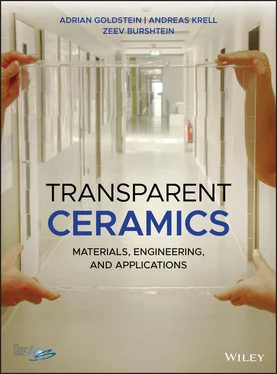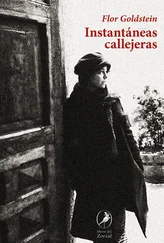1 Cover
2 Foreword Foreword Who had imagined in 1964 that the first solid-state laser of Nd 3+ -doped Y 3 Al 5 O 12 (YAG) single crystals might be replaced by Nd 3+ -doped YAG transparent laser ceramics? Requests to fabricate such transparent ceramics are at the frontier of materials science and everyone considered at this time that transparent ceramic materials could not be used for laser or optical materials. However, dreams came true in 1995 and now garnet transparent laser ceramics are commercialized and have been extended also to Ce 3+ -doped YAG as phosphors associated with blue LED for high power white lighting. Recently, the list of application of transparent ceramics, for which some of them are highly sophisticated, for laser media, phosphors, scintillators, armor windows, infrared domes, and electro-optical components have widely increase in all domains and have impacted our daily life. This book addresses precise topics on available transparent ceramics (TCs) materials, how they are processed, their applications, and aspects of the progress made in their engineering as well as our scientific understanding. Adrian Goldstein, Andreas Krell, and Zeev Burshtein, well-known authorities in the international community of the ceramics, animated during all their scientific lives by the passion of the field and the desire to communicate it, were able to pause and review carefully the accomplishments of this period, the remaining challenges, and future prospects. Clearly, the data presented are well explained, in correlation with the theoretical science and engineering background. This book answers well with the evolution of the transparent ceramics so that it will successfully help students and researchers for any developments still in a laboratory stage. As an example, data help to understand relationships between microstructures (porosity and size distribution of pores) and optical properties, and also processing strategies of densification and transparency. Their upgrading in the near future has to be relevant for industrial operations and will likely lead to significantly strengthen the economic relevance of the transparent ceramics. Students, scientists, and engineers working with ceramics should get this book providing extensive references to contemporary works and being a basis for studying the field. It covers applications through detailed case studies and therefore a comprehensive guide to the current status of transparent ceramics, well suited to readers who wish to use it, either to understand these materials or to solve specific problems. UCB Lyon 1, France Georges Boulon Emeritus Professor
3 Acknowledgments Acknowledgments We would like to thank some of the people who, in one way or other, had helped us in bringing this book to life: Prof. Julius Menessy, Dr. Michael Katz, Prof. Georges Boulon, Smadar Karpas, Prof. Ken-ichi Ueda, and Prof. Lisa Klein. Dr. Zeev Burshtein has authored Sections: 2.1 – 2.5 (with minor contributions from A. Krell and A. Goldstein) and Sections 5.2.9.1.1–5.2.9.1.3 (included).
4 General Abbreviations
5 1 Introduction1.1 Importance of Transparent Ceramics: The Book's Rationale Topic and Aims 1.2 Factors Determining the Overall Worth of Transparent Ceramics 1.3 Spectral Domain for Ceramics High Transmission Targeted in This Book 1.4 Definition of Transparency Levels 1.5 Evolution of Transmissive Ability Along the Ceramics Development History
6 2 Electromagnetic Radiation: Interaction with Matter 2.1 Electromagnetic Radiation: Phenomenology and Characterizing Parameters 2.2 Interference and Polarization 2.3 Main Processes which Disturb Electromagnetic Radiation After Incidence on a Solid 2.4 Physical Processes Controlling Light Absorption in the Optical Window Vicinity 2.5 Thermal Emissivity 2.6 Color of Solids
7 3 Ceramics Engineering: Aspects Specific to Those Transparent 3.1 Processing 3.2 Characterization
8 4 Materials and Their Processing 4.1 Introduction 4.2 Principal Materials Description
9 5 TC Applications 5.1 General Aspects 5.2 Brief Description of Main Applications
10 6 Future Developments
11 7 Conclusions
12 References
13 Index
14 End User License Agreement
1 Chapter 2 Table 2.1 Terms derived fromd qelectronic configurations. Table 2.2 Terms derived from f qelectronic configurations. Table 2.3 Racah's energies for alld qand a few relevant f qconfigurations. Table 2.4 Empiric B and C Constants for different representative 3d qconfigura... Table 2.5 Empiric B , C , and D Racah Constants for different representative fre... Table 2.6 Correlation table among atomic and ionic states' wave functions inO... Table 2.7 Correlation table among atomic and ionic states' wave-function spec...Table 2.8 Color data of individual spinel samples obtained from transmission ...
2 Chapter 3Table 3.1 Comments on particle size distribution records by different light s...
3 Chapter 4Table 4.1 Nonoptical properties of selected transparent ceramics.Table 4.2 Optical properties of selected transparent ceramics.Table 4.3 Characteristics of spinel/LiF (0–3.5%) discs (diameter = 58 mm) aft...Table 4.4 Main properties of transparent spinel ceramics.Table 4.5 Frequency of spinel lattice fundamental vibrations.Table 4.6 Properties of AlON ceramics.Table 4.7 Properties of alumina ceramics.Table 4.8 Properties of MgO ceramics.Table 4.9 Properties of YAG ceramics.Table 4.10 Properties of Y 2O 3ceramics.Table 4.11 Most frequent oxide impurities present in zirconia powders.Table 4.12 Properties of zirconia ceramics.Table 4.13 The density of a few types of zirconia ceramic.Table 4.14 Space group (for cubic lattices, also the “a” values are given) me...Table 4.15 Properties of ZnS and ZnSe ceramics.Table 4.16 PLZT general properties.Table 4.17 Electro-optic properties of PLZT; comparison with other ferroelect...Table 4.18 Electro-optic properties of PMN and PZN-PT ceramics.Table 4.19 Diamond properties.Table 4.20 Properties of GaP.
4 Chapter 5Table 5.1 Guiding quality criteria for transparent ceramics in major fields o...Table 5.2 Properties of some transparent glass-ceramics usable in armor appli...Table 5.3 Properties of some armor glasses.Table 5.4 Radii of TM +and RE +cations.
1 Chapter 1 Figure 1.1 Overall wavelength range of the spectrum of EMR (domain to which ... Figure 1.2 Transmission range of a few transparent ceramics and glasses show... Figure 1.3 Evolution of transparency during ceramic history (a) clay pitcher... Figure 1.4 First translucent, all-crystalline ceramic: imaging and microstru... Figure 1.5 Lamp (high pressure Na vapor) including vapors, envelope made of ... Figure 1.6 Nd:YAG rod-shaped ceramic gain media for solid-state lasers. Top:...
2 Chapter 2 Figure 2.1 Schematic illustration of a spatial slice (temporal snapshot imag... Figure 2.2 Demonstration of constructive and destructive interference cases ... Figure 2.3 Various light polarization forms: (a) linearly polarized and (b) ... Figure 2.4 Graphic representation of the refraction process. Figure 2.5 Dependence of optical lens focal length on the value of refractio... Figure 2.6 Wavelength dependence (“dispersion”) of the refractive index n ( λ ... Figure 2.7 Relationship between refraction index and dispersion for optical ... Figure 2.8 Deleterious effect of chromatic aberration. Figure 2.9 Plot of the partial dispersion ratio θ g,Fagainst refractive... Figure 2.10 Plot of partial dispersion against Abbé number ν d. Two exam... Figure 2.11 Light reflectance vs. incidence angle of its S and P polarizatio... Figure 2.12 Use of total reflection, at the core/cladding interface, for kee... Figure 2.13 The refraction index ellipsoid and graphic determination of the ... Figure 2.14 Cross section of the refractive index ellipsoid of a uniaxial cr... Figure 2.15 Schematic demonstration of light scattering by randomly disperse... Figure 2.16 Scattering form factor as function of the dimensionless
Читать дальше











